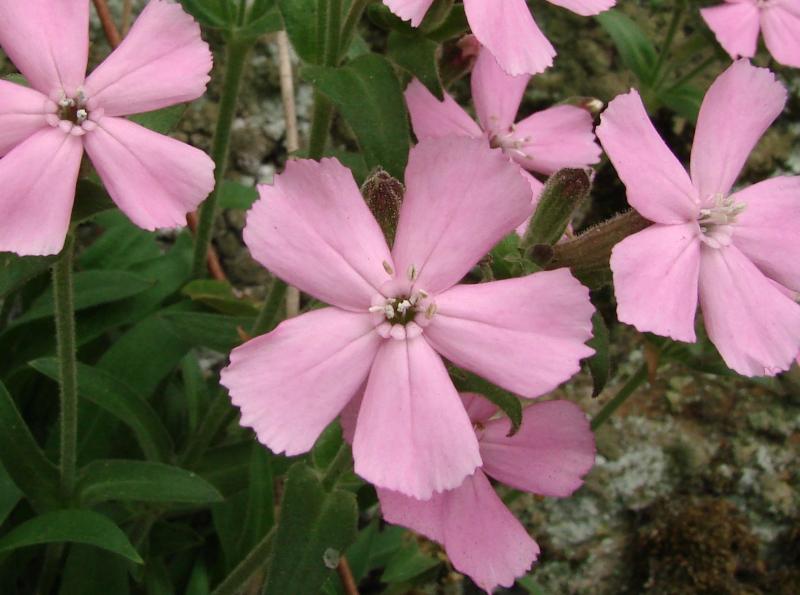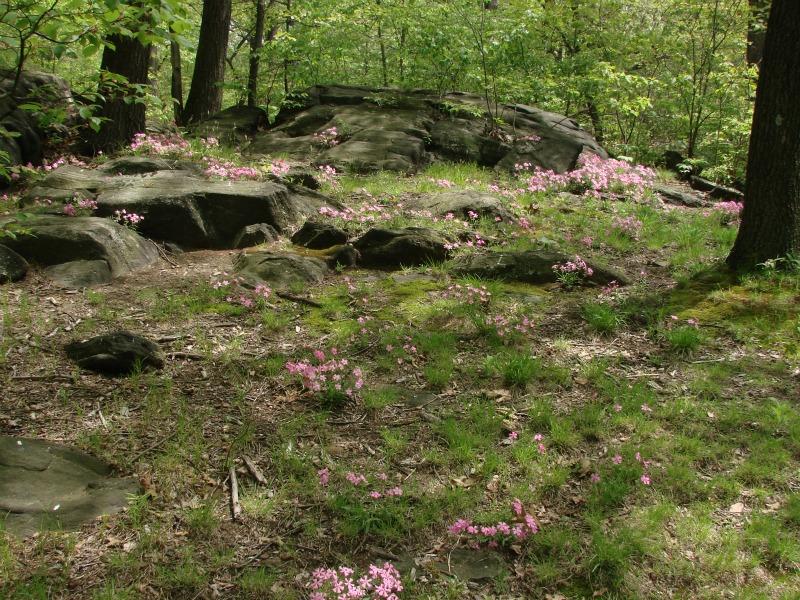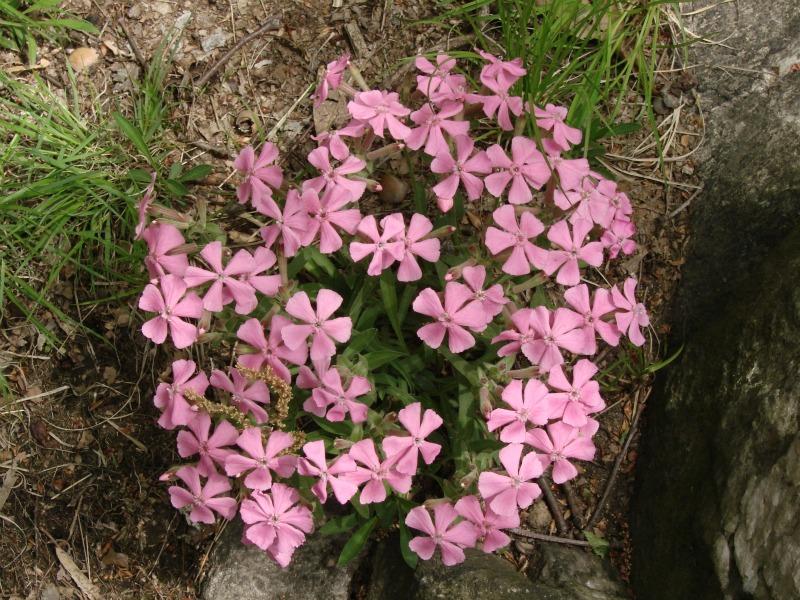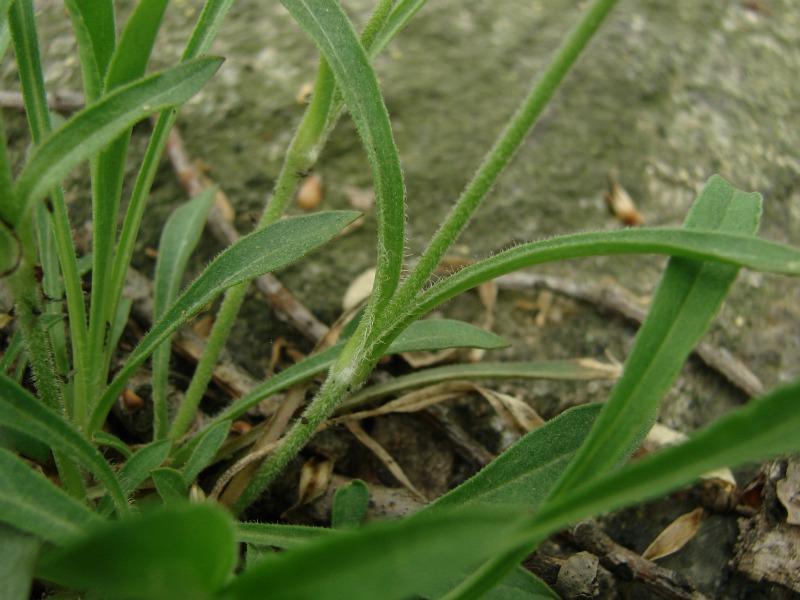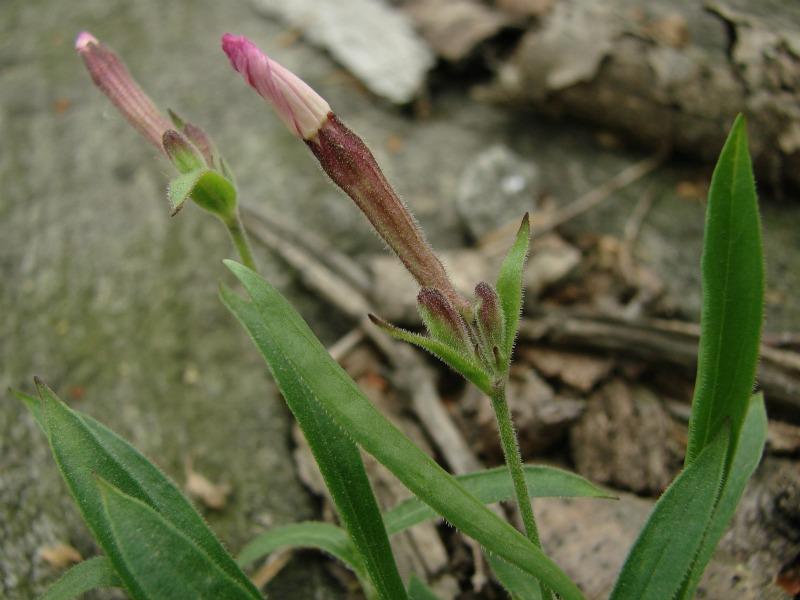Wild Pink
Silene caroliniana ssp. pensylvanica (Michx.) Clausen
- Class
- Dicotyledoneae (Dicots)
- Family
- Caryophyllaceae (Pink Family)
- State Protection
- Threatened
Listed as Threatened by New York State: likely to become Endangered in the foreseeable future. For animals, taking, importation, transportation, or possession is prohibited, except under license or permit. For plants, removal or damage without the consent of the landowner is prohibited.
- Federal Protection
- Not Listed
- State Conservation Status Rank
- S2
Imperiled in New York - Very vulnerable to disappearing from New York due to rarity or other factors; typically 6 to 20 populations or locations in New York, very few individuals, very restricted range, few remaining acres (or miles of stream), and/or steep declines.
- Global Conservation Status Rank
- G5T4T5
Apparently or Demonstrably Secure globally - The subspecies/variety is uncommon to common in the world, but not rare; usually widespread, but may be rare in some parts of its range; possibly some cause for long-term concern due to declines or other factors. More information is needed to assign either T4 or T5. (The species as a whole is common globally.)
Summary
Did you know?
Wild pinks are now widely available in the horticulture trade. There are three varieties of the species and they are separated geographically with variety caroliniana from the Southeast, variety pensylvanica from the Northeast and variety wherryi from the East-Central US. North Carolina is the only state where all three varieties grow.
State Ranking Justification
There are 12 existing populations but with more surveys it may be found to be more common on Eastern Long Island and the Southern Taconic Mountains. There are about 15 historical populations that no longer exist.
Short-term Trends
The short term trend is stable.
Long-term Trends
This plant was always limited in distribution in New York but numbers have declined from historical levels. There are fewer locations known from the North Fork and it may be gone from Western Long Island and Staten Island where it was known to occur. There are historical records from Dutchess County but no plants have been found there recently.
Conservation and Management
Threats
It is subject to elimination on roadsides by improper roadside maintenance. Some populations have been lost to development and others to exotic invasive species where they invade cliff and other rocky communities.
Conservation Strategies and Management Practices
Roadside and trailside habitats must be kept open but plants must not be mowed repeatedly during the growing season. Cliff and open rocky habitats should be kept free of invasive species.
Research Needs
Research is needed to find out why this species is limited in distribution in common habitats.
Habitat
Habitat
On Eastern Long Island the plants are in open grassy and shrubby areas along the edge of sandy trails, roads and powerlines as well as stabilized dunes of red cedar near the coast. In New York City and Westchester County they are in partial sun on low cliffs of metamorphic rock and on rocky ridges under oak forest. In the Taconic Mountains the plants are on southwest-facing slopes of ridges in chestnut oak forest with schist and granite ledges, rocky outcrops, and talus. They are growing in grassy openings and scattered around on rock outcrops (NYNHP 2011). Occurs in rocky, usually calcareous woods (Gleason and Conquist 1991). Dry sandy, gravelly or rocky woods and openings (Fernald 1950).
Associated Ecological Communities
- Appalachian oak-hickory forest
(guide)
A hardwood forest that occurs on well-drained sites, usually on ridgetops, upper slopes, or south- and west-facing slopes. The soils are usually loams or sandy loams. This is a broadly defined forest community with several regional and edaphic variants. The dominant trees include red oak, white oak, and/or black oak. Mixed with the oaks, usually at lower densities, are pignut, shagbark, and/or sweet pignut hickory.
- Cliff community
(guide)
A community that occurs on vertical exposures of resistant, non-calcareous bedrock (such as quartzite, sandstone, or schist) or consolidated material; these cliffs often include ledges and small areas of talus.
- Maritime grassland
(guide)
A grassland community that occurs on rolling outwash plains of the glaciated portion of the Atlantic coastal plain, near the ocean and within the influence of offshore winds and salt spray.
- Maritime red cedar forest
(guide)
A conifer forest that occurs on dry sites near the ocean. Eastern red cedar is the dominant tree, often forming nearly pure stands. Other characteristic trees include post oak and black cherry.
- Pitch pine-oak forest
(guide)
A mixed forest that typically occurs on well-drained, sandy soils of glacial outwash plains or moraines; it also occurs on thin, rocky soils of ridgetops. The dominant trees are pitch pine mixed with one or more of the following oaks: scarlet oak, white oak, red oak, or black oak.
- Pitch pine-oak-heath rocky summit
(guide)
A community that occurs on warm, dry, rocky ridgetops and summits where the bedrock is non-calcareous (such as quartzite, sandstone, or schist), and the soils are more or less acidic. This community is broadly defined and includes examples that may lack pines and are dominated by scrub oak and/or heath shrubs apparently related to fire regime.
- Pitch pine-oak-heath woodland
(guide)
A pine barrens community that occurs on well-drained, infertile, sandy soils. The structure of this community is intermediate between a shrub-savanna and a woodland. Pitch pine and white oak are the most abundant trees.
- Pitch pine-scrub oak barrens
(guide)
A shrub-savanna community that occurs on well-drained, sandy soils that have developed on sand dunes, glacial till, and outwash plains.
Associated Species
- Amelanchier nantucketensis (Nantucket shadbush)
- Carex pensylvanica (Pennsylvania sedge)
- Cypripedium acaule (pink lady's-slipper)
- Euphorbia ipecacuanhae (ipecac spurge)
- Helianthemum canadense
- Hieracium
- Juniperus virginiana
- Lechea
- Luzula
- Nuttallanthus canadensis (old-field-toad-flax)
- Panicum virgatum (switch grass)
- Quercus ilicifolia (scrub oak, bear oak)
- Quercus velutina (black oak)
- Rubus flagellaris (northern dewberry)
- Schizachyrium scoparium
- Tephrosia virginiana (goat's-rue)
Range
New York State Distribution
Plants grow from Eastern Long Island west to New York City and southern Westchester County. There are disjunct populations in the Taconic Range of southern Columbia County.
Global Distribution
This subspecies occurs from Massachusetts west through New York and Pennsylvania to Eastern Ohio, south to Virginia, North Carolina, and Northeast Tennesee.
Identification Comments
General Description
Wild pinks form small to large colonies of low, herbaceous, perennial plants with petiolate basal leaves about 5-12 cm long with acute tips. The few to many stems are about 8-20 cm tall, with dense glandular hairs, and have 2-3 pairs of sessile leaves with ciliate margins. The flowers are in short, dense clusters with a tubular calyx covered in glandular hairs. The showy petals are white to dark pink and widest at the tip with ragged edges. There is a ring of appendages at the base of the petals where the white stamens can be seen sticking out. The fruit is a capsule with tiny, prominently inflated seeds that are covered with little projections (tubercules).
Best Life Stage for Proper Identification
The best time to identify the plant is when it is in flower and easily visible. It is difficult to see among other vegetation once the flowers produce fruit.
Similar Species
When this plant is in flower there are no other plants that look like it.
Best Time to See
Flowers are visible from late May through early June. Plants with fruits may be visible through August.
- Flowering
- Fruiting
The time of year you would expect to find Wild Pink flowering and fruiting in New York.
Wild Pink Images
Taxonomy
Wild Pink
Silene caroliniana ssp. pensylvanica (Michx.) Clausen
- Kingdom Plantae
- Phylum Anthophyta
- Class Dicotyledoneae
(Dicots)
- Order Caryophyllales
- Family Caryophyllaceae (Pink Family)
- Order Caryophyllales
- Class Dicotyledoneae
(Dicots)
- Phylum Anthophyta
Synonyms
- Melandrium pensylvanicum (Michx.) Rohr.
- Silene caroliniana var. pensylvanica (Michx.) Fern.
Additional Resources
Best Identification Reference
Mitchell, Richard S. Portulaceae through Caryophyllaceae of New York State. Contributions to a flora of New York State XI. Bulletin No. 486. New York State Museum.
Other References
Fernald, M.L. 1950. Gray's manual of botany. 8th edition. D. Van Nostrand, New York. 1632 pp.
Gleason, Henry A. and A. Cronquist. 1991. Manual of Vascular Plants of Northeastern United States and Adjacent Canada. The New York Botanical Garden, Bronx, New York. 910 pp.
Holmgren, Noel. 1998. The Illustrated Companion to Gleason and Cronquist's Manual. Illustrations of the Vascular Plants of Northeastern United States and Adjacent Canada. The New York Botanical Garden, Bronx, New York.
New York Natural Heritage Program. 2024. New York Natural Heritage Program Databases. Albany, NY.
Weldy, T. and D. Werier. 2010. New York flora atlas. [S.M. Landry, K.N. Campbell, and L.D. Mabe (original application development), Florida Center for Community Design and Research http://www.fccdr.usf.edu/. University of South Florida http://www.usf.edu/]. New York Flora Association http://newyork.plantatlas.usf.edu/, Albany, New York
Links
About This Guide
This guide was authored by: Stephen M. Young
Information for this guide was last updated on: November 8, 2011
Please cite this page as:
New York Natural Heritage Program. 2024.
Online Conservation Guide for
Silene caroliniana ssp. pensylvanica.
Available from: https://guides.nynhp.org/wild-pink/.
Accessed July 27, 2024.
